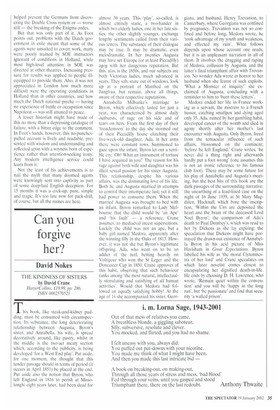Can you forgive her?
David Nokes
THE KINDNESS OF SISTERS by David Crane HarperCollins. £19.99, pp. 286, ISBN 0002570521 This book, like steak-and-kidney pudding, must be consumed with circumspection. Its substance, the long deteriorating relationship between Augusta, Byron's sister, and Annabella, his wife, is spread decoratively around, like pastry, whilst in the middle is the two-act meaty section which, according to the publicity, is being developed 'for a West End play'. Put aside, for one moment, the thought that this tender passage should in terms of period (it occurs in April 1851) be placed at the end. Put aside also the notion that Byron, who left England in 1816 to perish at Missolonghi eight years later, had been dead for
almost 30 years. This 'play', so-called, is almost entirely static, a two-hander in which two elderly ladies, one in her late sixties, the other slightly younger, exchange lengthy sentiments culled from their various letters. The substance of their dialogue may be true. It may be dramatic, even melodramatic. In her twenties Augusta may have set Europe (or at least Piccadilly) agog with her dangerous reputation. But this, alas, is the 1850s, and our subjects are both Victorian ladies, much advanced in years. They sob, stare out of windows, look up at a portrait of Manfred on the Jungfrau, but remain, above all things, aware of their respective reputations.
Annabella Milbanke's marriage to Byron, which effectively lasted for just a year, was characterised by almost daily outbursts, of rage on his side and of tears on hers. From the first day of their 'treaclemoon' to the day she stormed out of their Piccadilly house clutching their five-week-old daughter, Ada, in her arms there were constant rows. Summoned to gaze upon the infant, Byron let out a terrible cry: 'Oh! What an instrument of torture I have acquired in your The reason for his rage against both wife and daughter was his illicit sexual passion for his sister Augusta. This relationship, despite his various affairs, was the dominating love of his life. Both he and Augusta married in attempts to control their intemperate lust; yet it still had power to consume them. When the married Augusta was brought to bed with an infant. Byron remarked to Lady Melbourne that the child would be 'an Ape' and 'his fault' — a reference, Crane assumes. to mediaeval incest superstitions. Luckily the child was not an ape, but a baby girl named Medora, apparently after the winning filly in the Oaks of 1813. However, it was not she but Byron's legitimate offspring, Ada, who went on to be an addict of the turf, betting heavily on Voltigeur who won the St Leger and the Doncaster Cup in 1850. Crane approves of this habit, observing that such behaviour ranks among the most natural, intellectually stimulating and satisfying of all human activities'. Would that Medora had followed an equally satisfying hobby! At the age of 14 she accompanied his sister, Geor
giana. and husband. Henry Trevanion, to Canterbury, where Georgiana was confined by pregnancy. Trevanion was not so confined and before long, Medora wrote, he 'took advantage of my youth and weakness, and effected my ruin'. What follows depends upon whose account one reads, but it is an unpleasant narration in all of them. It involves the drugging and raping of Medora, collusion by Augusta, and the latter's final triumphant affair with Trevanion. No wonder Ada wrote in horror to her husband when she learnt of such exploits. 'What a Monster of iniquity!' she exclaimed of Augusta, concluding with a reminder to him to 'burn these letters'.
Medora ended her life in France working as a servant, the mistress to a French hussar, catching smallpox and dying aged only 35. Ada, ruined by her gambling habit, developed cancer of the womb and died in agony shortly after her mother's last encounter with Augusta. Only Byron, freed from the tentacular influence of such affairs, blossomed on the continent; 'before he left England,' Crane writes, 'he never did a thing right and afterwards hardly put a foot wrong' (one assumes this is not an ironic reference to his famous club foot). There may be some future for his play of Annabella and Augusta's meeting, but the best bits of this book are the dark passages of the surrounding narrative: the unearthing of a lead-lined case on the night of 16 June 1939, at St Mary Magdalen. Hucknall, which bore the inscription, 'Within the Urn are deposited the heart and the brain of the deceased Lord Noel Byron'; the comparison of Ada's death to Paul Dombey's, which was read to her by Dickens as she lay expiring; the speculation that Dickens might have portrayed the drawn-out existence of Annabella Byron in his acid picture of Miss Havisham in Great Expectations. Byron labelled his wife as 'the moral Clytemnestra of her lord' and Crane speculates on which later novelist comes closest to encapsulating her dignified death-in-life, He ends by choosing D. H. Lawrence, who wrote, 'Remain quiet within the convention' and you will be 'happy in the long run', but 'be passionate' and find that security 'a walled prison'.






























































 Previous page
Previous page